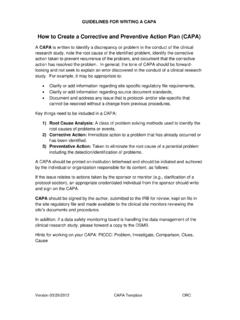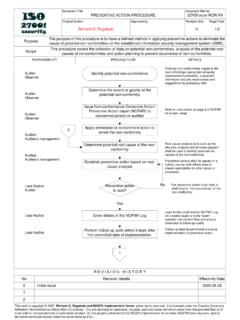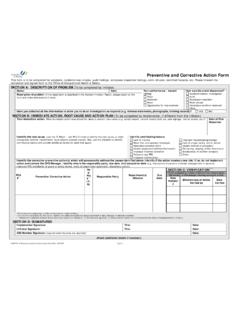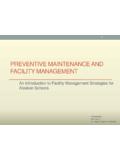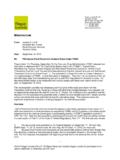Transcription of Managing corrective and preventive action (CAPA) in a life ...
1 IBM asset management solutions White paperManaging corrective and preventive action (CAPA) in a life sciences environment. March 2007 Contents 2 Executive summary 4 Setting the stage 5 When is CAPA relevant? 6 How to manage CAPA 7 Incident management 8 CAPA process 9 Background 10 Benefits 12 IBM Maximo Asset Management as a framework to support CAPA processes 17 Conclusion 19 For more information 19 About Tivoli software from IBMM anaging corrective and preventive action (CAPA) in a life sciences 2 Executive summaryIn the life sciences industry, the process of Managing non-conformities or defects from manufacturing, engineering, quality or other quality data sources, such as product complaints leading to corrective or preventive actions, is a formal and controlled one used to identify, correct and prevent problems that occur.
2 Today, the industry is facing strong pressure from regulatory bodies government as well as from the industry itself to focus on quality and, at the same time, the need to increase asset utilization and efficiencies, and lower cost as much as possible. A corrective and preventive action (CAPA) program is one tool to achieve these key part of a CAPA program is root cause analysis, which is utilized to ascertain the source of a problem, non-conformity or defect so that corrective or preventive action can be taken to address the programs have achieved some notable successes, first with the nuclear industry and subsequently in many other asset-intensive industries such as utilities, chemicals, pharmaceuticals and life sciences.
3 As with any program, there are wide variances in program governance, structure, funding and effectiveness. As early as 1999, the Federal Drug Administration (FDA), began providing CAPA guidelines1 and started to actively enforce CAPA requirements as part of its Quality System Inspection Technique (QSIT) initiative. According to research conducted in 2005 by Axendia a specialized business consulting firm focusing on the life sciences industry, 50 percent of the top 10 FDA inspectional observation items (each commonly known as a 483 ) were CAPA Since the publication of the Guide to Inspections of Quality Systems, and with FDA s shift to QSIT and risk-based compliance orientation, CAPA will continue to be a key focus during FDA CAPA programs have been implemented with few tangible enterprise-wide benefits.
4 Probably the most common reason for disappointing results is the failure to connect and fully integrate CAPA programs with work management strategies and solutions, and other supporting corporate-wide information white paper focuses on the asset-intensive companies that needs to reposition their assets from operational necessities to strategic imperatives, which allows the enterprise to consistently make decisions that result in higher quality and more reliable and risk-averse operations. Actively Managing asset-related CAPA is important for these companies as this can create an obvious link between the quality management system and the enterprise asset management (EAM) or computerized maintenance management system (CMMS).
5 This document will also explore the role of handling non-conformities or defects, Managing their occurrence or incidents, and the CAPA process that drives operational excellence, helps companies monitor and manage their regulatory compliance efforts, supports their goal of zero defects and enhances each company s ability to document the whole process of occurrence and , this white paper will provide an overview of IBM Maximo Asset Management and its capabilities to support corporate initiatives such as complaint and incident management and CAPA, as well as to provide a framework for all stages of the CAPA process.
6 This process includes identification, determination, implementation and the permanent embedding of CAPA as part of a continuous improvement process in regulatory environments like life sciences and healthcare. Managing corrective and preventive action (CAPA) in a life sciences Highlights Managing corrective and preventive action (CAPA) in a life sciences A new risk management agenda is placing new demands on life sciences the stageToday, risk management is referred to as enterprise risk management. There has been a shift away from traditional compliance and insurance motivated risk management, to management that is more closely linked to business performance and long-term society commitments.
7 A new risk agenda is emerging in the life sciences industry resulting in new demands on business and new ways to manage business. The FDA provides guidance for a risk-based approach because risk management has become a more important tool to minimize safety-related risk. The FDA is actively providing guidelines on risk management. As with any program, there are wide variances in program governance, structure, funding and effectiveness. As mentioned earlier, the FDA has been actively enforcing CAPA requirements and reported that 50 percent of the top 10 FDA 483s are CAPA related.
8 Based on feedback from the industry and an industry study, it appears that in operational environments 50 percent to 80 percent of all CAPA s have asset-related FDA initiative on Process Analytical Technologies (PAT) outlines a system perspective and facilitates the introduction of new technologies to the design, development and manufacturing of drug products. PAT focuses on integration of data (output from process control systems) into quality management systems and other related information management industry trend to benefit from Lean/Six Sigma initiatives will clearly impact the reliability and quality of critical assets to increase efficiency of production processes in the life sciences are focused on ascertaining the root cause of problems or events and taking action to prevent their recurrence.
9 This enables the company to conduct largely error-free operations over a long period of time and to more consistently make decisions that result in higher quality and more reliable operations. In parsing any CAPA definition, there are subtle but key differences between corrective action and preventive action . corrective action is defined as an action undertaken to eliminate the cause of an existing non-conformity, defect or other undesirable situation to prevent recurrence. preventive action is defined as an action undertaken to eliminate the cause of a potential non-conformity, defect or other undesirable situation to prevent an key words are different in the two definitions: existing and potential, and recurrence and occurrence.
10 corrective action relates to the root cause of an incident, whereas preventive action relates to the occurrence of an incident. When is CAPA relevant?Currently, there are five different types of information sources that can trigger a CAPA. Complaints from customers, either direct or indirect users (or consumers) Process deviations as a result of a manufacturing inconsistency or production failure, or an engineering non-conformity, which causes the defect relative to the production deviation, non-conformance or out-of-specification that may occur Laboratory investigation or analysesInternal audits or audits from regulatory bodies such as the FDA that identify differences or deviations from given standards in the business or production processes or non-compliance to production validation guidelines Grassroots efforts by employees.


